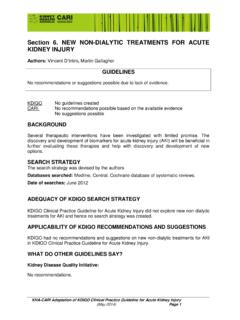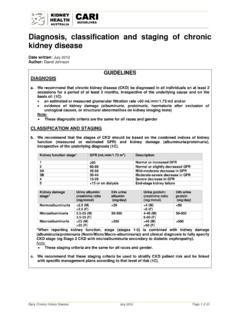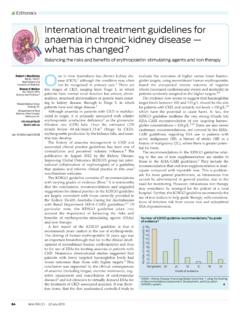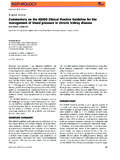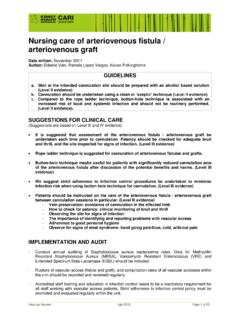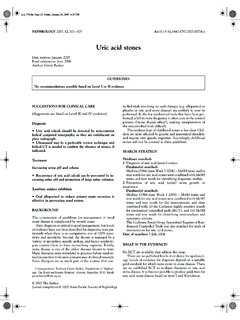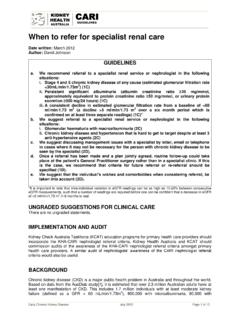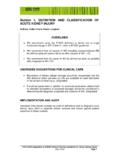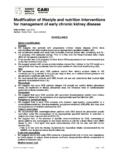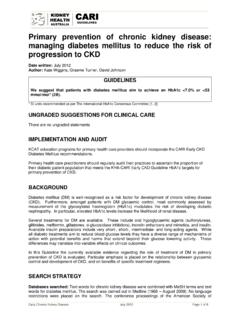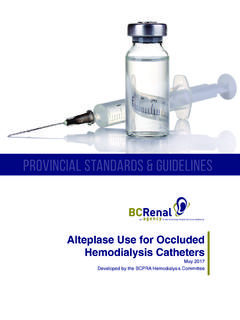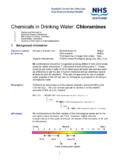Transcription of Water quality for haemodialysis - KHA-CARI Guidelines
1 The CARI Guidelines Caring for Australians with Renal Impairment dialysis Adequacy haemodialysis (July 2005) Water quality for haemodialysis Date written: January 2005 Final submission: July 2005 Guidelines No recommendations possible based on Level I or II evidence SUGGESTIONS FOR CLINICAL CARE (Suggestions are based on Level III and IV evidence) Ensure regular testing and audit of Water treatment system and quality of Water produced for dialysis . Note some of the limitations to accurate chemical and microbial testing. Be familiar with local practice in municipal Water treatment and testing procedures. Ultrapure Water may reduce long-term risk of accelerated vascular damage, improve response to erythropoetic agents and reduce catabolic nutritional state. Infusion fluid for haemodiafiltration or haemofiltration must be produced with strict observance of the manufacturer s validated process. Final filtration must ensure 7 log reduction in bacterial count of ultrapure fluid.
2 European Guidelines should be the basis for optimal dialysate production. Background Each patient is exposed to large quantities of Water during a treatment session in the form of dialysate. Intravenous fluid replacement for use with high-flux membranes for haemodiafiltration or haemofiltration can now be produced on-line from dialysate. Chemical or microbial contamination can cause serious (fatal) consequences. There have been many reports over the past 40 years related to the adverse effects of such contamination. Recent reports have suggested more subtle, no less significant, effects on the immune system and development of premature atherosclerosis which can contribute to the well documented excess risk of cardiac disease and fatality when compared with the general population. Developments in membrane composition have increased the possibility of transfer of microbial products into the bloodstream. Safeguards must be more stringent and carefully observed.
3 Extensive reviews of the nature, origin, consequences and prevention of these risks have been produced and regularly updated. In particular, the European Best Practice The CARI Guidelines Caring for Australians with Renal Impairment dialysis Adequacy haemodialysis (July 2005) Guidelines (EBPG) and the Association for the Advancement of Medical Instrumentation (AAMI) have recommended chemical and microbial standards for Water and dialysate for haemodialysis and convective therapies (EBPG 2002, AAMI 2004). These standards concur on most issues. In the absence of new evidence and acknowledging their comprehensive quality , it is intended to indicate a preference where they may differ (gap analysis). Attention is drawn to the detailed explanation in the Appendices of EBPG 2002 and AAMI 2004, which describe the processes required to achieve, maintain and monitor these standards. Search strategy Databases searched: MeSH terms and text words for dialysis were combined with MeSH terms and text words for Water purification, chlorine, fluorides, Water , Water microbiology, Water supply and Water pollution, and then combined with the Cochrane highly sensitive search strategy for randomised controlled trials.
4 The search was carried out in Medline (1966 July Week 2 2004). The Cochrane Renal Group Trials Register was also searched for trials not indexed in Medline. Date of searches: 27 July 2004. What is the evidence? Chemical contaminants Aluminium, chlorine compounds (including trihalomethanes such as chloramine), nitrates, sulphates, copper and zinc are the most important of the substances known to have particular toxicity for haemodialysis patients. The effects include dementia, osteomalacia, haemolytic anaemia, nausea, vomiting and acidosis (Alfrey et al 1976; Ward et al 1978; Kaiser 1985; Eaton et al 1973; Ward 1996; Carlson 1970; Comty et al 1974; Ivanovich 1969; Petrie 1977; AAMI 2004). The second group of chemical contaminants are usually not present in excess quantities in municipal Water treated by modern methods. The maximum allowable limits are set at 10% of the Environmental Protection Agency Safe Drinking Water Act. Examples include arsenic, chromium, lead and selenium.
5 The third group is physiological substances which if present in excess amount, may cause injury. Examples include calcium, potassium and sodium. There are no significant differences between AAMI and EBPG with regard to the maximum allowable limits for most chemicals in these three groups. Chlorine and chloramine toxicity is a well established phenomenon. Haemolytic anaemia is the major consequence; potentially fatal hyperkalaemia may follow severe haemolysis. Resistance to erythropoietic agents has been reported at chloramine levels of mg/L (Perez-Garcia & Rodriguez-Benitez 1999). Special risk may exist close to dosing points in Water distribution systems or rural systems with high dosing levels of chloramine. Free chlorine can damage some reverse osmosis membranes (AAMI 2004, p. 9). The CARI Guidelines Caring for Australians with Renal Impairment dialysis Adequacy haemodialysis (July 2005) Aluminium removal requires reverse osmosis; pretreatment Water softening may reduce some of the load.
6 Deionisers may be less effective if aluminium is present in significant amounts at neutral pH, mostly in colloidal form, because it does not carry a charge and is therefore not removed by the process (AAMI 2004). Chlorine products require carbon adsorption in certain situations such as when high natural levels of N chloramines or high pH is present or use of phosphates (ortho or poly). Other methods may involve sodium metabisulphite or ascorbic acid or as in pharmaceutical and electronic industries, redox alloy media or UV irradiation at 185 nm. Unpredictable variations in feed Water levels, especially in summer, may exceed the filter s adsorption capacity. Chloramines require 4 5 times longer than does free chlorine to be effectively adsorbed (AAMI 2004). Microbial contaminants Pyrogenic reactions have been associated with bacterial contamination of dialysate, usually from the Water delivered to the dialyser, at levels in excess of 2000 cfu/mL (Favero 1998).
7 Contamination with Water -based organisms (usually slow growing Gram negative Pseudomonads) may cause clinical and subclinical consequences. Pyrogenic reactions due to exo/endotoxins have been associated with excess microbial levels in the dialysate system. Corrrection of potential /demonstrated microbial contamination has resolved outbreaks (AAMI 2004). Fungal, yeast or algal organisms have occasionally been implicated, especially when treatment methods have been either not functioning or below common standards (Pouria et al 1998). Fatal intoxication has been reported in a haemodialysis unit in Brazil. There is some controversy regarding the extent of passage of bacterial products across dialyser membranes. Low-flux membranes may be more resistant to such penetration. Concern has focussed on the more permeable membranes used for high-flux diaysis and diafiltration (with on-line production of replacement fluid). Lonnemann and colleagues (2001) reported that at moderate levels (Pseudomonas endotoxin 50 EU/mL) of bacterial contamination of dialysate for in vitro dialysis with highly permeable synthetic membranes of poysulphone or polyethersulphone, there was no evidence of significant change in human mononuclear cell content of proinflammatory cytokines such as interleukin-1 beta or tumor necrosis factor alpha.
8 This field has been confused by issues regarding endotoxin antibody measurement, endotoxin plasma levels or mononuclear cell response releasing cytokines likely to promote a chronic inflammatory state (Summary: AAMI 2004, p 32). Ultrapure Water is defined as bacterial count < FU/mL and endotoxin < EU/mL and is recommended by both European and American Guidelines for use with high-flux dialysers. Sterile fluid, defined as containing < 1 CFU/1000L and endotoxin < EU/mL, is required for on-line replacement during haemodiafiltration or haemofiltration. Ledebo (2002) has demonstrated the capacity to produce such fluid quality by the use of ultra-pure feed Water , dialysate and subsequent endpoint ultrafiltration. Both AAMI The CARI Guidelines Caring for Australians with Renal Impairment dialysis Adequacy haemodialysis (July 2005) and EBPG support this standard, which is required by the respective Pharmacopeia regulations. Unfortunately, there have been no reliable prospective controlled studies investigating the clinical benefit arising from using ultrapure dialysate (Schiffl et al 2000).
9 Studies have been uncontrolled or non-randomised or associated with change to synthetic membranes shown to limit endotoxin penetration into the bloodstream. Nevertheless, there is a strong belief that ultrapure fluid is now the standard. AAMI have not mandated that level but consider it to be desirable for high-flux membrane use. EBPG require the standard for high-flux dialysis . Stenvinkel et al (2000) has proposed that there is an association between low level microbiological contaminants in dialysate and the malnutrition-inflammatory-atherosclerosi s (MIA) syndrome. It remains a speculative theory without validation in the clinical dialysis context. Endotoxins from Gram negative bacteria are mainly lipopolysaccharides which can be detected by the Limulus amoebocyte lysate (LAL) assay. Other possible endo- and exotoxins are peptidoglycans, muramyl-dipeptides and exotoxin A. These are not measured by the LAL assay (Lonnemann 2000). Microbial testing: extensive coverage in AAMI and EBPG There is no agreement regarding which media, temperature or duration of culture should be used to recover organisms.
10 The EBPG preference is for room temperature (20 22 C), 5 7 days culture with nutrient-poor media (Reasoners 2A or tryptone glucose extract agar: TGEA) which is reported to increase the recovery of bacteria. AAMI accepts 38 C, standard agar, not blood or chocolate, for 2 days and 28 C for longer periods for more accurate counts of bacteria. The membrane filtration technique is recommended and is obligatory for the detection of low level counts. Optimally, a 500 mL sample of fluid is filtered to achieve a detection level of FU/mL. Clinical laboratories not able to provide the membrane technique should use the spread plate assay with pipette (not calibrated loop) method. The latter has a lower limit detection level of 1000 C FU/mL, which is not acceptable when the maximum allowed limit for dialysate is 100 or 200 CFU/mL. For endotoxin testing, the kinetic LAL test is more accurate and specific. However, the gel clot LAL test is more readily available and commonly used: range , , , , and EU/mL.
